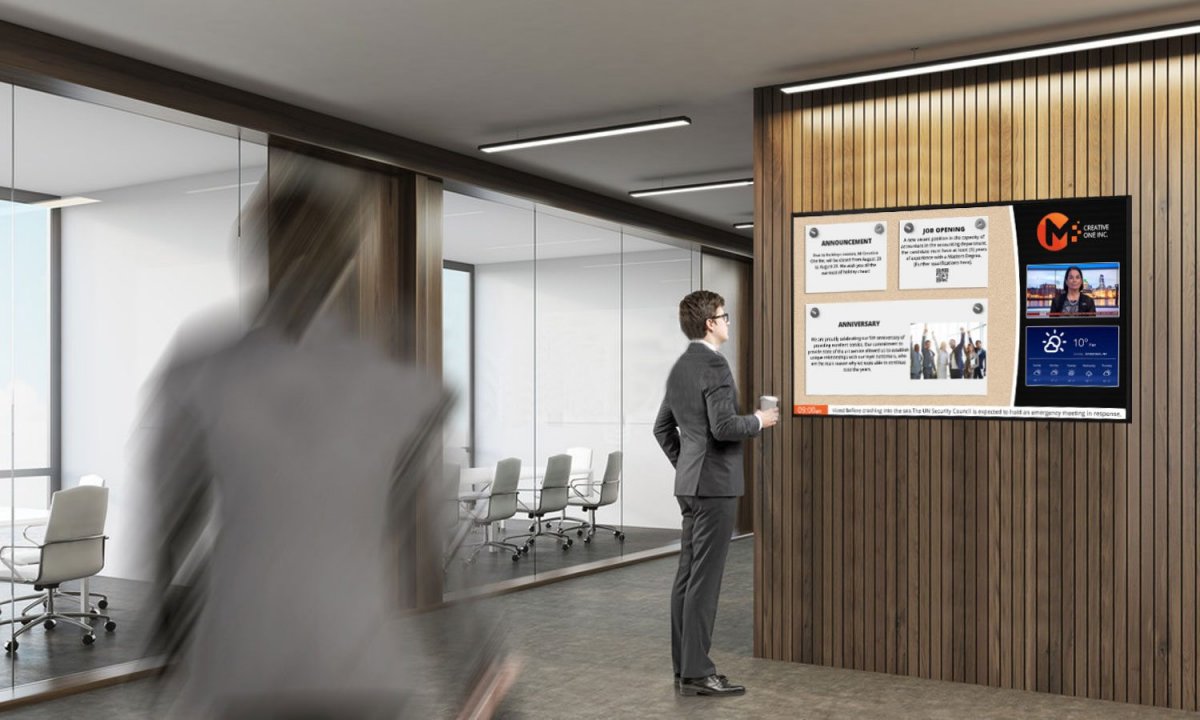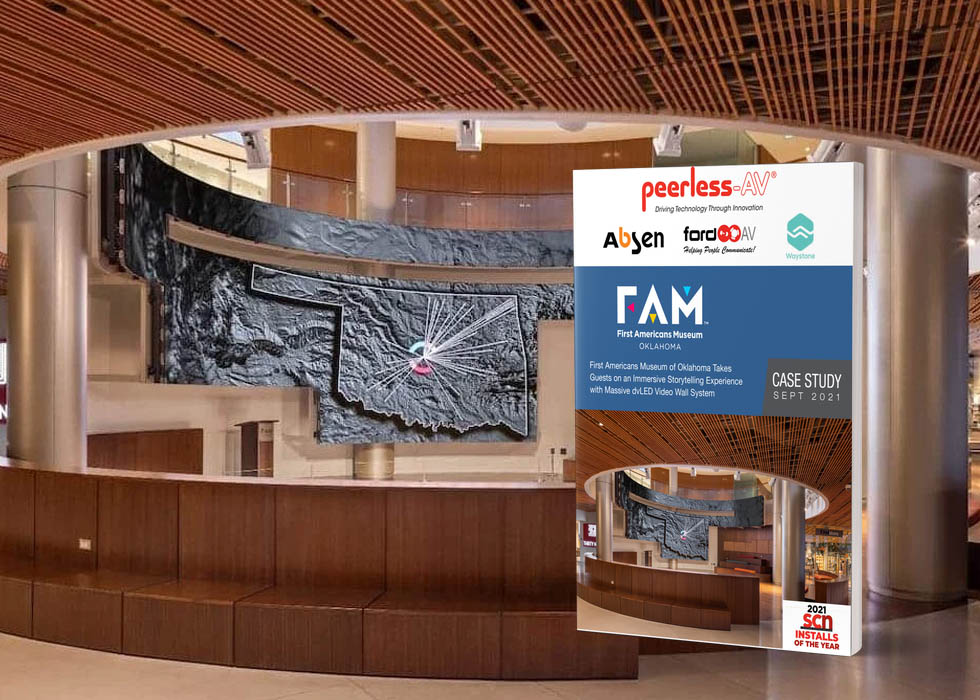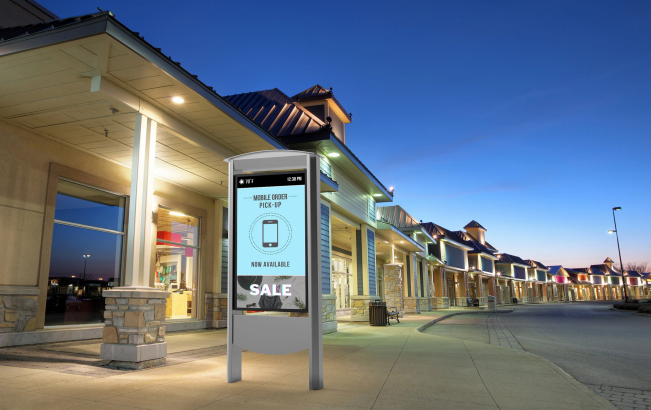Digital Signage in the Workplace Will Still Thrive Post-Pandemic. Here's Why.
Posted on May 7, 2021
Workplace was among the hottest vertical markets in digital signage before the pandemic, and despite all the discussion around a shift to working from home, workplace will be a hot vertical market when COVID-19 is in our collective rearview mirror.
Offices may be reconfigured and reduced in total footprints because of much more flexible working arrangements. But most organizations will still have offices and perhaps, more than ever, they'll need digital signage technology to communicate what will
be a lot of changes in how things work and are now done.
Digital meeting room signs saw rapid adaptation in workplace environments in recent years because tablet-sized screens at the doorways to meeting rooms ended a lot of chaos and conflict over who had a room booked, when and why.
 I have spoken to numerous digital signage software firms that coded data integrations with room booking
and calendar systems and added meeting room support. All of them confirmed that a small piece of business for the signs gradually led to more digital signage work with those customers, as those end-users saw the difference digital made with that,
and started thinking about other ways digital displays could more effectively communicate information and guide some operations.
I have spoken to numerous digital signage software firms that coded data integrations with room booking
and calendar systems and added meeting room support. All of them confirmed that a small piece of business for the signs gradually led to more digital signage work with those customers, as those end-users saw the difference digital made with that,
and started thinking about other ways digital displays could more effectively communicate information and guide some operations.Think of what's happening as offices start to re-populate, and people come back in, perhaps after a year away, to find changed floor plans and arrangements like desk hoteling, or what's also called hot desks. Instead of an assigned office, cubicle or
open plan workstation, they may find themselves needing to book a workstation by the day, and then find that desk through a digital locator map.
Think of what may be a lot of new rules and processes for everything from health safety to visitor procedures, and how that gets communicated and reinforced. Screens are going to do a far more effective and pervasive job than company emails.
As mostly an observer of all this digital signage activity in the workplace, I've been intrigued at how much focus is placed on office environments and how little, in relative terms, is placed on industrial and health care environments.
So-called "white collar" office environments are somewhat contained and predictable, and relatively easy to reach through various means. People in these environments are conditioned to correspondence, and in relatively close quarters, so "the word" can
get around pretty efficiently.
In manufacturing, food processing, logistics and other industrial environments, a lot is going on, safety risks tend to be much more heightened, and the building footprints can be huge. Almost no one sits at a desk or uses a company PC, unless that PC
runs a machine or monitors a system. In a lot of scenarios, like food production and packaging, a substantial block of staff may not even have a solid command of English.
If a company has digital signage screens in common areas and decision points, it has a toolset to reach those people - repeatedly, at the right moments, and in multiple languages.
Screens also do a better job of guiding work. A few years ago, I did consulting work for an automaker, and saw during a plant tour sets of corkboards at team stations on the floor that were filled with spreadsheets and chart print-outs. Team members
had to lean in and squint to see the information, and it was aged data the moment someone clicked the Print button at their desk.
Here was a screamingly obvious case for an interactive display that could launch any needed information to full screen, populated with real-time data, not with whatever the state was at 8:15 that morning.
So there's a lot of untapped opportunity for digital signage solutions in industrial settings, and just as much, or more, in health care environments.
Digital signage companies have targeted medical clinics for 20-plus years with the concept of using screens in waiting rooms to take the minds of people off the wait and worry, but that's just the most obvious application for screens in medical environments.
For patients and visitors, there's a need for updated and targeted information the moment they walk in, and the opportunity to improve that experience through the right communications. That can mean wayfinding maps and guidance tools for big medical campuses. That
might mean directories offered in more than just English. Think of cities like Minneapolis that have large immigrant populations, like the Somalis in Minnesota.
I've seen hospitals that use video walls and other targeted displays to offer calm, comfort and hope through visuals - showing, for example, patients who got better, were discharged, and moved on.
But the real story for health care digital signage, mostly untapped, is as a workplace. Big health care facilities are also big offices, with work areas and break areas, operations areas, loading docks, cafeterias and retail. There's a lot going on and
a lot to communicate, and in the case of active patient care, a need for instant, accurate communications.
A lot of health care facilities still use dry erase marker boards at nursing stations to mark out status and assignments, even when patient care records are entered in software systems. Most patient rooms still have manual information at the doorway,
when tablets or small flat panel displays could contain every necessary piece of real-time information about the patients in those rooms.
Health care also has a lot of meeting rooms and a lot of potential use for premium displays. Conventional office meeting rooms, restaurants and retail won't really see a need or benefit from coming technologies like 8K flat panels. It's more resolution
than they need. But in situations like health care, medical imaging work can be shown in all its depth and complexity, with all those pixels.
My big point here is that the digital signage and pro AV ecosystems have seen, for some time now, a business opportunity in workplaces. But that opportunity is much broader than the four walls of conventional offices.






